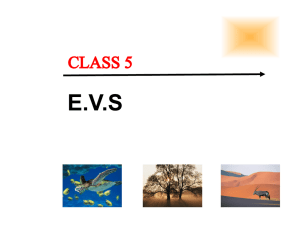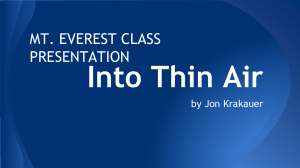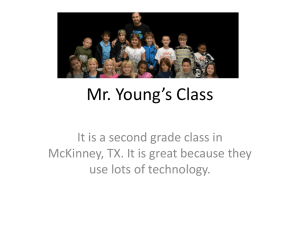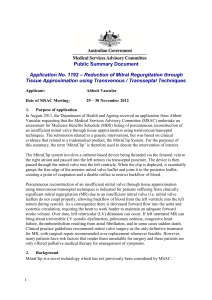EVEREST II - ACC/AHA Guidelines for the Management of Patients
advertisement
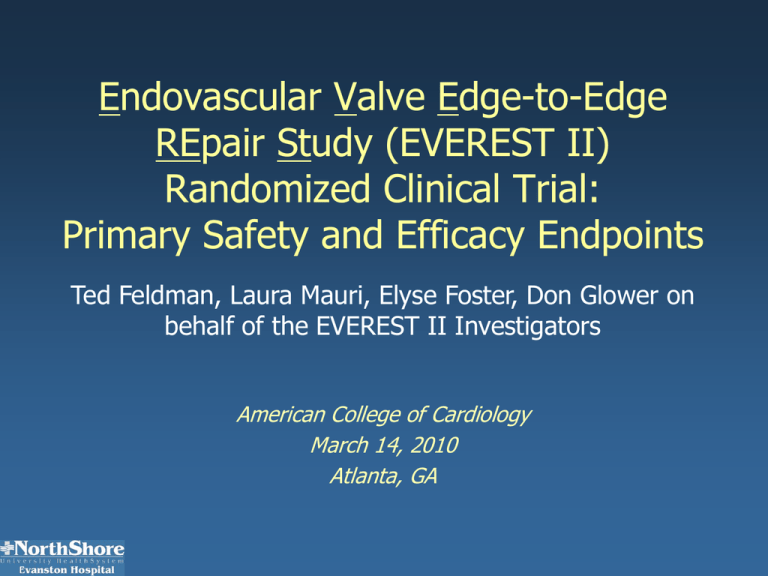
Endovascular Valve Edge-to-Edge REpair Study (EVEREST II) Randomized Clinical Trial: Primary Safety and Efficacy Endpoints Ted Feldman, Laura Mauri, Elyse Foster, Don Glower on behalf of the EVEREST II Investigators American College of Cardiology March 14, 2010 Atlanta, GA Disclosures Research Grants – Abbott, Edwards Consultant – Abbott, Edwards 2 Investigational Device only in the US; Not available for sale in the US Perspective >250,000 cases of significant Mitral Regurgitation diagnosed annually in the US Current therapeutic options: • Medical management – Effective in symptom management – Ineffective in treating underlying pathophysiology or disease progression • Surgical Repair or Replacement (Standard of Care) – Effective yet invasive with associated morbidity – Only ~20% of patients with significant MR undergo MV surgery Unmet need for an effective less invasive option 3 Investigational Device only in the US; Not available for sale in the US Catheter-Based Mitral Valve Repair MitraClip® System 4 Investigational Device only in the US; Not available for sale in the US Clinical Experience Study Population n EVEREST I (Feasibility)* Non-randomized 55 EVEREST II* Pre-randomization 60 EVEREST II High Risk Registry 78 EVEREST II (Pivotal) Randomized patients (2:1 MitraClip to Surgery) 279 REALISM (Continued Access) High Risk & Non High Risk European Experience 184 MitraClip 95 Surgery 266 472 Total 1,115 MitraClip *Percutaneous Mitral Valve Repair Using the Edge-to-Edge Repair: Six months Results of the EVEREST Phase I Clinical trial, JACC 2005;46:2134-2140. Percutaneous Mitral Repair with the MitraClip System: Safety and Midterm Durability in the Initial EVEREST Cohort, JACC 2009; 54:686-694. Data as of 2/15/2010. Investigational Device only in the US; Not available for sale in the US 5 EVEREST II Randomized Clinical Trial Study Design 279 Patients enrolled at 37 sites Significant MR (3+-4+) Specific Anatomical Criteria Randomized 2:1 Device Group MitraClip System N=184 Control Group Surgical Repair or Replacement N=95 Echocardiography Core Lab and Clinical Follow-Up: Baseline, 30 days, 6 months, 1 year, 18 months, and annually through 5 years 6 Investigational Device only in the US; Not available for sale in the US EVEREST II Randomized Clinical Trial Study Organization Principal Investigators: Ted Feldman, MD Evanston NorthShore University HealthSystem Donald Glower, MD Duke University Medical Center Academic Research Organization: Laura Mauri, MD Harvard Clinical Research Institute Data Safety Monitoring Board: Richard Shemin, MD University of California, Los Angeles Clinical Events Committee: Don Cutlip, MD Echocardiography Core Lab: Elyse Foster, MD Sponsor: Abbott Vascular Structural Heart (Evalve) Harvard Clinical Research Institute University of California, San Francisco Menlo Park, CA 7 Investigational Device only in the US; Not available for sale in the US EVEREST Clinical Investigators T Feldman, J Alexander, R Curran, E Chedrawy, S Smart, M Lampert A Wang, D Glower, J Jollis T Byrne, P Tibi, HK Fang, JM Morgan R Quesada, J Lamelas, N Moreno, R Machado P Grayburn, B Hamman, R Hebeler, M Mack, W Ryan A Eisenhauer, M Davidson, L Cohn, J Wu J Hermiller, D Heimansohn, K Allen, D Segar M Rinaldi, E Skipper, R Steigel, J Cook, G Rose S Kar, G Fontana, A Trento, R Kass, W Cheng, R Siegel, K Tolstrup P Whitlow, T Mihaljevic, N Smidera, L Sevensson, E Roselli, L Rodriquez, W Stewart H Wasserman, W Gray, A Stewart, M Williams, M Argenziano, S Homma, R Pizzarello, L Gillam P Block, Z Ghazzal, T Vassiliades, R Martin, J Merlino, S Lerakis B Whisenant, S Clayson, B Reid, S Horton, J Orford R Smalling, G Letsou, J Walkes, C Loghin W Pedersen, V Kshettry, F Eales, T Flavin, T Kroshus, R Bae O Nass, D Gangahar, R Jex, R Kacere SC Wong, OW Isom, L Girardi, K Krieger, R Devereux, R Mishra J Slater, A Galloway, G Perk, I Kronzon S Ramee, C Van Meter, P Parrino, C Lavie, Y Gilliland, VS Lucas R Kipperman, S Lucas, RM Bodenhamer, J Randolph, J Williams R Leung, R MacArthur, J Mullen, D Ross, J Choy P Kramer, B Castlemain, A Schwartz, L Crouse, V Pasnoori A Berke, N Robinson, R Colangelo, P Damus, H Fernandez, J Taylor, N Bercow, A Katz M O'Donnell, M Qureshi, A Pruitt, B Kong, B McAllister, S Girard T Bajwa, D O’Hair, D Kress, K Sagar JT Maddux, M Sanz, S Tahta, JM Maxwell, B Berry, J Knapp W Gray, M Reisman, W Curtis, D Gartman, J Teply, D Warth, K Krabill P Fail, K Paape, T Fudge, M Trotter, M Allam, E Feinberg, V Tedesco, D Solet E Horlick, T David, M Borger, M Mezody R Low, N Young, K Shankar, R Calhoun, W Bommer J Carroll, J Cleveland, R Quaife H Herrmann, M Acker, YJ Woo, F Silvestry, S Wiegers S Bailey, E Sako, J Erikson DS Lim, I Kron, J Kern, J Dent, H Gutgesell E Fretz, J Ofiesh, M Mann K Kent, S Boyce. P Sears-Rogan J Lasala, M Moon, R Damiano, B Lindman, A Zajarias, J Madrazo G Hanzel, F Shannon, M Sakwa, A Abbas, M Gallagher, P Markovitz NorthShore University HealthSystem, Evanston, IL Duke University, Durham, NC Banner Good Samaritan Medical Center, Phoenix, AZ Baptist Hospital of Miami, Miami, FL Baylor University Medical Center, Dallas, TX Brigham and Women’s Hospital, Boston, MA The Care Group, Indianapolis, IN Carolinas Medical Center, Charlotte, NC Cedars-Sinai Medical Center, Los Angeles, CA The Cleveland Clinic, Cleveland, OH Columbia University, New York, NY; Danville, CT Emory University Hospital, Atlanta, GA Latter Day Saints Hospital, Salt Lake City, UT Memorial Hermann Hospital, Houston, TX Minneapolis Heart Institute, Minneapolis, MN Nebraska Heart Institute, Lincoln, NE New York Presbyterian Hospital, New York, NY NYU Medical Center, New York, NY Ochsner Clinic Foundation, New Orleans, LA Oklahoma Heart Hospital, Okalahoma City, OK Royal Alexandra Hospital, Edmonton, AB, Canada Shawnee Mission Medical Center, Shawnee Mission, KS St. Francis Hospital, Long Island, NY St. Joseph’s Mercy Hospital, Ypsilanti, MI St. Luke’s Medical Center, Milwaukee, WI St. Patrick's Hospital & Health Science Ctr, Missoula, MT Swedish Medical Center, Seattle, WA Terrebonne General Medical Center, Houma, LA Toronto General Hospital, Toronto, ON, Canada University of California at Davis, Sacramento, CA University of Colorado Health Sciences Center, Denver, CO University of Pennsylvania, Philadelphia, PA University of Texas Health Sciences Ctr, San Antonio, TX University of Virginia, Charlottesville, VA Victoria Heart Institute Foundation, Victoria BC, Canada Washington Hospital Center, Washington DC Washington University Medical Center, St. Louis, MO William Beaumont Hospital, Royal Oak, MI Interventional Cardiologist, Cardiac Surgeon, Echocardiologist Investigational Device only in the US; Not available for sale in the US 8 EVEREST II Randomized Clinical Trial Key Inclusion/Exclusion Criteria Exclusion Inclusion • Candidate for MV Surgery • Moderate to severe (3+) or severe (4+) MR – Symptomatic – Creatinine >2.5mg/dl o >25% EF & LVESD ≤55mm – Asymptomatic with one or more of the following o o o o LVEF 25-60% LVESD ≥40mm New onset atrial fibrillation Pulmonary hypertension ACC/AHA Guidelines JACC 52:e1-e142, 2008 • AMI within 12 weeks • Need for other cardiac surgery • Renal insufficiency • Endocarditis • Rheumatic heart disease • MV anatomical exclusions – Mitral valve area <4.0cm2 – Leaflet flail width (≥15mm) and gap (≥10mm) – Leaflet tethering/coaptation depth (>11mm) and length (<2mm) 9 Investigational Device only in the US; Not available for sale in the US EVEREST II Randomized Clinical Trial Baseline Demographics & Co-morbidities Age (mean) Male Congestive heart failure Coronary artery disease Myocardial infarction Angina Atrial fibrillation Cerebrovascular disease Peripheral vascular disease Cardiomyopathy Hypercholesterolemia Hypertension Moderate to severe renal disease Diabetes Previous cardiovascular surgery MR Severity: 3+ to 4+ MR Etiology: Degenerative / Functional Device (%) Control (%) n=184 n=95 P 67.3 years 62.5 90.8 47.0 21.9 31.9 33.7 7.6 6.5 17.9 61.0 72.3 3.3 7.6 22.3 95.7 73 / 27 65.7 years 66.3 77.9 46.3 21.3 22.2 39.3 5.3 11.6 14.7 62.8 78.9 2.1 10.5 18.9 92.6 73 / 27 0.32 0.60 <0.01 >0.99 >0.99 0.12 0.42 0.62 0.17 0.61 0.80 0.25 0.72 0.50 0.54 0.48 0.81 10 Investigational Device only in the US; Not available for sale in the US EVEREST II Randomized Clinical Trial Demographic Comparison EVEREST II RCT 2008 STS Database Isolated 1st Elective Operation for MR* n=279 Repair Replace High Volume Hospitals (>140/Yr) Age yrs (mean) 68 60 61 59 ≥65 yrs 58% 37% 45% n/a ≥75 yrs 32% n/a n/a 0% NYHA Class III or IV 50% 26% 45% n/a CHF 86% 41% 58% n/a Hypertension 75% 60% 67% 43% Diabetes Mellitus 9% 13% 23% 6.5% COPD / Chronic Lung Disease 15% 17% 29% n/a EF (mean) 60% 53% 55% 56% *Gammie JS et al Influence of Hospital Procedural Volume on Care Process and Mortality for Patients Undergoing Elective Surgery for Mitral Regurgitation. Circ 2007;115:881-887. Investigational Device only in the US; Not available for sale in the US 11 EVEREST II Randomized Clinical Trial Primary Endpoints Safety Major Adverse Event Rate at 30 days Per protocol cohort Superiority hypothesis Effectiveness Clinical Success Rate Pre-Specified MAEs Death Major Stroke Re-operation of Mitral Valve Urgent / Emergent CV Surgery Myocardial Infarction Renal Failure Deep Wound Infection Ventilation >48 hrs New Onset Permanent Atrial Fib Septicemia GI Complication Requiring Surgery All Transfusions ≥2 units • Freedom from the combined outcome of – Death – MV surgery or re-operation for MV dysfunction – MR >2+ at 12 months Per protocol cohort Non-inferiority hypothesis 12 Investigational Device only in the US; Not available for sale in the US EVEREST II Randomized Clinical Trial Additional Analyses Intention to Treat Safety • Major Adverse Event Rate at 30 days Effectiveness • Freedom from the combined outcome of death, MV surgery >90 days or re-operation for valve dysfunction >90 days post Index procedure, and MR >2+ at 12 months Clinical Benefit (per protocol cohort) MR Severity Left Ventricular Function NYHA Functional Class Quality of Life (SF-36 Survey) 13 Investigational Device only in the US; Not available for sale in the US EVEREST II RCT: Patient Flow Per Protocol Cohort: Analysis of Device Performance Randomized Cohort n=279 Device Group n=184 Randomized, not treated Device, n=6 Control, n=15 Treated n=178 Control Group n=95 Treated n=80 (86% MV repair) Acute Procedural Success Not Achieved Acute Procedural Success Achieved Acute Procedural Success (APS) = MR ≤2+ at discharge 30 days 30 days 99% Clinical Follow-up 99% Clinical Follow-up 12 months 12 months 98.5% Clinical Follow-up 98% Echo Follow-up 94% Clinical Follow-up 92% Echo Follow-up n=41 n=137 n=136 n=134 n=79 Investigational Device only in the US; Not available for sale in the US n=74 14 EVEREST II RCT: Patient Flow Post MitraClip Procedure Acute Procedural Success Not Achieved Acute Procedural Success Achieved n=137 n=41 No Additional Intervention n=11 2nd MitraClip Procedure n=2 MV Surgery Post MitraClip Procedure n=28 MV Surgery Post MitraClip Procedure n=9 2nd MitraClip Procedure n=3 n=37 81% Follow-up 96% MR ≤2+ at 12 months 15 Investigational Device only in the US; Not available for sale in the US EVEREST II RCT: Patient Flow Intention to Treat Cohort: Analysis of Treatment Strategy Randomized Cohort n=279 Device Group n=184 Control Group n=95 30 days 30 days 95% Follow-up 84% Follow-up 12 months 12 months 92% Follow-up 78% Follow-up n=180 n=175 n=94 n=89 Patients randomized but not treated are included in ITT analysis 16 Investigational Device only in the US; Not available for sale in the US EVEREST II RCT: Primary Endpoints Per Protocol Cohort Safety Effectiveness Major Adverse Events Clinical Success Rate* 30 days 12 months Device Group, n=136 Device Group, n=134 72.4% 9.6% Control Group, n=79 pSUP <0.0001 Control Group, n=74 pNI =0.0012 57.0% 0 20 40 Met superiority hypothesis • Pre-specified margin = 6% • Observed difference = 47.4% • 97.5% LCB = 34.4% LCB = lower confidence bound UCB = upper confidence bound 60 87.8% 0 20 40 60 80 100 Met non-inferiority hypothesis • Pre-specified margin = 31% • Observed difference = 15.4% • 95% UCB = 25.4% * Freedom from the combined outcome of death, MV surgery or re-operation for MV dysfunction, MR >2+ at 12 months Investigational Device only in the US; Not available for sale in the US 17 EVEREST II RCT: Primary Safety Endpoint Per Protocol Cohort 30 Day MAE, non-hierarchical Death Major Stroke Re-operation of Mitral Valve Urgent / Emergent CV Surgery Myocardial Infarction Renal Failure Deep Wound Infection Ventilation >48 hrs New Onset Permanent Atrial Fib Septicemia GI Complication Requiring Surgery All Transfusions ≥2 units* TOTAL % of Patients with MAE *p<0.0001 if include Major Bleeding only # Patients experiencing event Device Group (n=136) 0 0 0 0 0 0 0 0 0 0 1 (0.7%) 12 (8.8%) 9.6% Control Group (n=79) 2 (2.5%) 2 (2.5%) 1 (1.3%) 4 (5.1%) 0 0 0 4 (5.1%) 0 0 0 42 (53.2%) 57.0% p<0.0001* (95% CI 34.4%, 60.4%) Investigational Device only in the US; Not available for sale in the US 18 Additional Analyses Intention to Treat Safety & Effectiveness Clinical Benefit (per protocol cohort) • • • • MR Severity Left Ventricular Function NYHA Functional Class Quality of Life 19 Investigational Device only in the US; Not available for sale in the US EII RCT: Safety & Effectiveness Endpoints Intention to Treat Cohort Safety Effectiveness Major Adverse Events Clinical Success Rate* 30 days 12 months Device Group, n=180 Device Group, n=175 15.0% Control Group, n=94 66.9% pSUP <0.0001 Control Group, n=89 pNI =0.0005 47.9% 0 20 40 Met superiority hypothesis • Pre-specified margin =2% • Observed difference = 32.9% • 97.5% LCB = 20.7% LCB = lower confidence bound UCB = upper confidence bound 60 74.2% 0 20 40 60 80 100 Met non-inferiority hypothesis • Pre-specified margin = 25% • Observed difference = 7.3% • 95% UCB = 17.8% * Freedom from the combined outcome of death, MV surgery or re-operation for MV dysfunction >90 days post Index procedure, MR >2+ at 12 months Investigational Device only in the US; Not available for sale in the US 20 EVEREST II RCT: MR Reduction Per Protocol Cohort Device Group Control Group 100% 80% ≤2+ 60% ≤2+ 81.5% 3+/4+ 97.0% 3+/4+ 40% 20% 3+/4+ 18.5% 0% Baseline n=137 12 Months n=119 Baseline n=80 12 Months n=67 21 Investigational Device only in the US; Not available for sale in the US EVEREST II RCT: MR Reduction Per Protocol Cohort 100% Device Group Control Group 2+ 2+ 1+ 80% 60% 3+/4+ 40% 3+/4+ 1+ 0% 58.2% 18.4% (7/38) Replacement 33.6% 20% 1+-2+ 3+/4+ 17.9% 36.1% 1+-2+ 11.8% 2+ 0 7.7% (1/13) Replacement 18.5% 2+ 7.5% 13.4% 3.0% Baseline n=137 12 Months n=119 Baseline n=80 12 Months n=67 22 Investigational Device only in the US; Not available for sale in the US EVEREST II RCT: Left Ventricular Volume Per Protocol Cohort 200 Device Group n=118, matched data 200 p<0.0001 p<0.0001 160 120 p=0.0005 80 Volume (ml) Volume (ml) 160 Control Group n=65, matched data 120 40 40 0 0 LVEDV LVESV Baseline p=0.0255 80 LVEDV LVESV 12 Months LVEDV = left ventricular end diastolic volume LVESV = left ventricular end systolic volume Pre-specified hypothesis Investigational Device only in the US; Not available for sale in the US for statistical analysis 23 EVEREST II RCT: Left Ventricular Dimension Per Protocol Cohort Control Group n=65, matched data Device Group n=118, matched data 6 p<0.0001 6 5 p=0.0564 4 3 2 Dimension (cm) 5 Dimension (cm) p<0.0001 4 3 2 1 1 0 0 LVID diastole LVID systole Baseline p=0.4785 LVID diastole LVID systole 12 Months LVIDd = left ventricular internal diameter, diastole Pre-specified hypothesis LVIDs = left ventricular internal diameter, systole Investigational Device only in the US; Not available for sale in the US for statistical analysis 24 EVEREST II RCT: NYHA Functional Class Per Protocol Cohort 100 Device Group Control Group p<0.0001 p<0.0001 I Percent Patients I 80 II I 60 40 0 97.6% NYHA Class I/II I 87.9% NYHA Class I/II III III 20 II II II IV IV Baseline 12 months n=124, Matched data III Baseline 12 months n=66, Matched data Hypothesis not pre-specified for statistical analysis Investigational Device only in the US; Not available for sale in the US 25 Score EVEREST II RCT: Quality of Life, SF-36 Survey Per Protocol Cohort 30 Day Scores 60 50 Device Group 12 Month Scores Control Group p<0.0001 P=0.2910 p<0.0001 P=0.0043 60 50 40 40 30 30 20 20 10 10 0 0 PCS MCS n=120, matched pairs PCS MCS n=64, matched pairs Baseline PSC = Physical Component Summary MCS = Mental Component Summary 30 days Device Group Control Group P<0.0001 P<0.0001 PCS P=0.0057 P=0.0017 MCS n=110, matched pairs PCS MCS n=60, matched pairs 12 Months Hypothesis not pre-specified for statistical analysis 26 Investigational Device only in the US; Not available for sale in the US EVEREST II RCT: Summary Safety & effectiveness endpoints met • Safety: MAE rate at 30 days – MitraClip device patients: 9.6% – MV surgery patients: 57% • Effectiveness: Clinical Success Rate at 12 months – MitraClip device patients: 72% – MV Surgery patients: 88% Clinical benefit demonstrated for MitraClip System and MV surgery patients through 12 months – Improved LV function – Improved NYHA Functional Class – Improved Quality of Life Surgery remains an option after the MitraClip procedure 27 Investigational Device only in the US; Not available for sale in the US EVEREST II RCT: Conclusion The MitraClip procedure is an important therapeutic option for selected patients with significant mitral regurgitation given the demonstrated safety, effectiveness and clinical benefit. 28 Investigational Device only in the US; Not available for sale in the US


